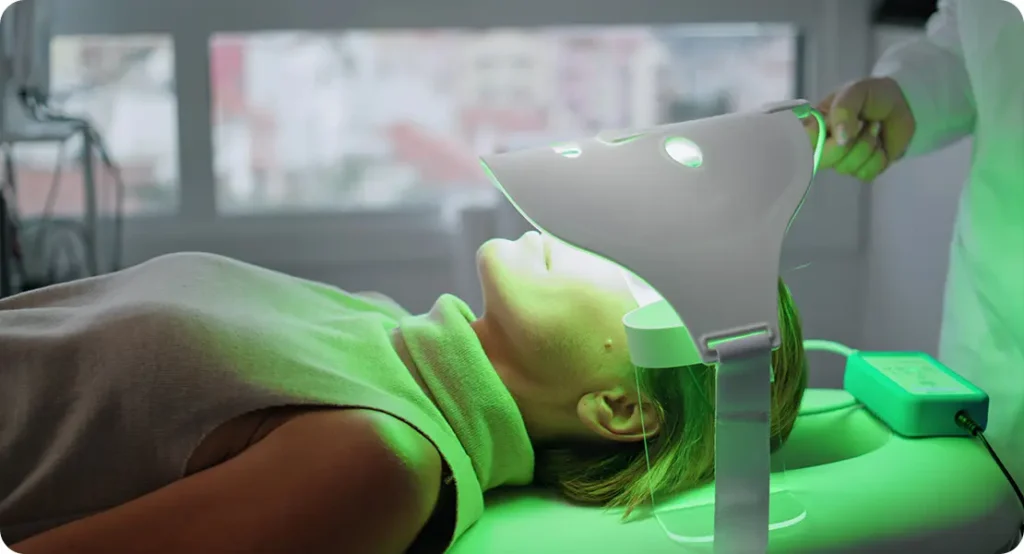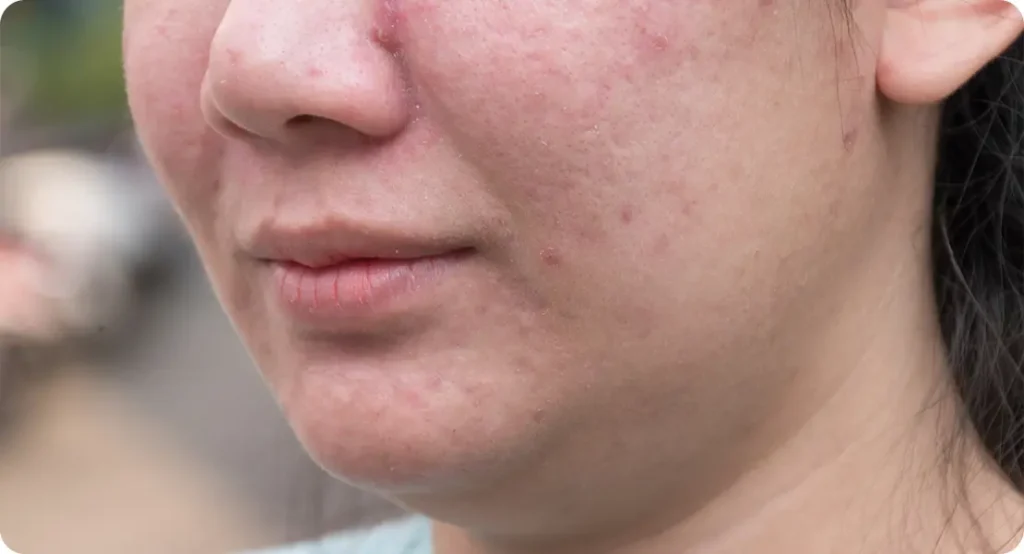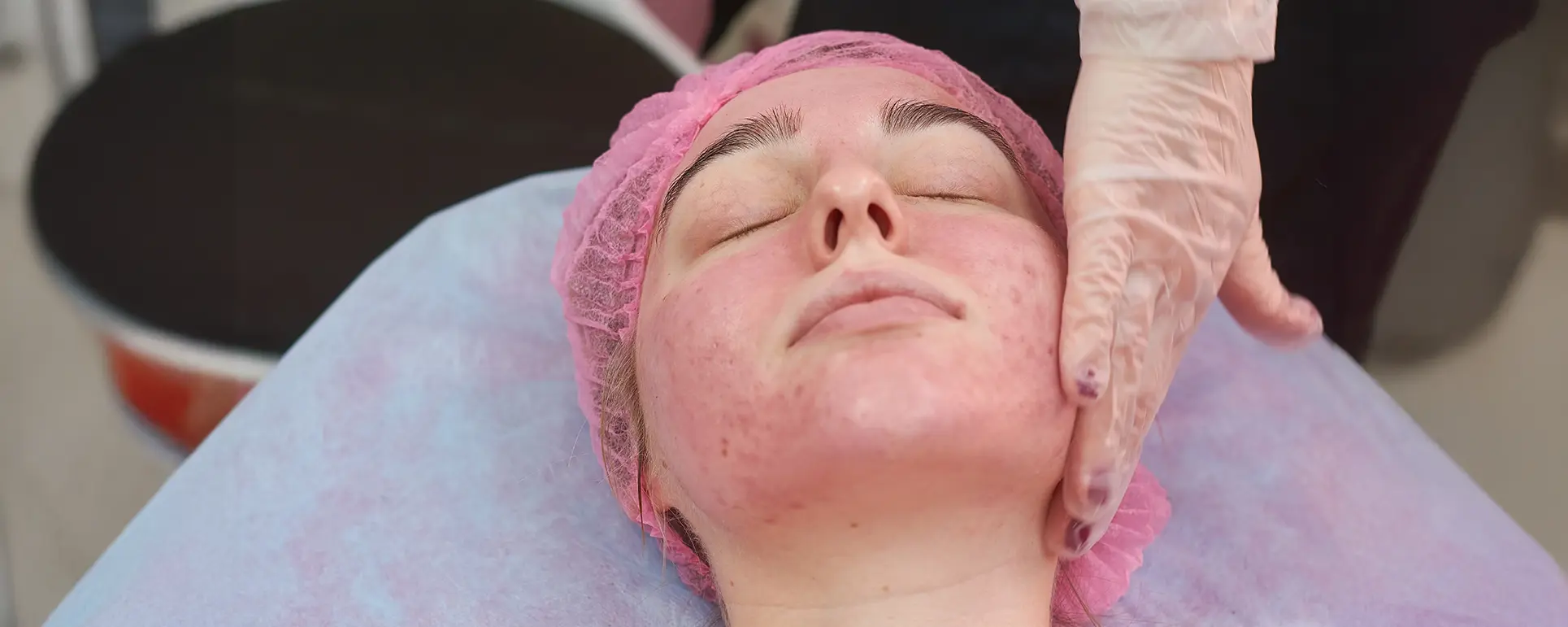Rosacea is frustrating enough when it shows up uninvited but it’s even more disheartening when it doesn’t respond to the usual treatments. You’ve tried prescription creams, antibiotics, lifestyle changes, maybe even laser therapy and yet, the persistent redness, burning, flare-ups, and bumps still won’t budge. If that sounds familiar, you’re not alone.
Many rosacea sufferers, especially those with more stubborn or advanced forms of the condition, find themselves hitting a wall with traditional approaches. The emotional toll can be just as heavy as the physical symptoms impacting confidence, comfort, and even social life. But there’s hope.
In 2025, dermatologists are approaching treatment-resistant rosacea with a fresh perspective. Thanks to a deeper understanding of the condition’s root causes like skin barrier dysfunction, immune system involvement, and gut-skin connection new, personalised strategies are making a real difference. From advanced prescription options and combination therapies to diet tweaks, laser protocols, and barrier-repair skincare, the latest solutions are more tailored, more scientific, and more effective than ever before.
Whether you’ve been battling rosacea for years or just realised your current treatment isn’t cutting it, this guide will walk you through what top dermatologists recommend now and how you can finally get the relief you deserve.
1. What Makes Rosacea “Treatment-Resistant”?
Rosacea is a complex skin condition, and while some people see improvement with standard treatments like topical metronidazole, azelaic acid, or oral antibiotics others find that their symptoms persist, worsen over time, or return despite consistent treatment. This phenomenon is often referred to as treatment-resistant rosacea, and it can be particularly frustrating for patients who are actively seeking relief.
There are several reasons why rosacea may be difficult to manage effectively. In some cases, genetics play a role if you have a family history of rosacea, your skin may be predisposed to chronic inflammation. Another major factor is the presence of undiagnosed or overlooked triggers. Common rosacea triggers include spicy foods, alcohol, sun exposure, hot beverages, stress, and certain skincare ingredients. If these triggers aren’t identified and avoided, even the best treatments may have limited success.
An incorrect or overly aggressive skincare routine can also worsen rosacea symptoms. Using harsh cleansers, physical scrubs, or alcohol-based toners may strip the skin’s barrier, leading to increased irritation and flare-ups. Additionally, rosacea can sometimes overlap with other skin conditions like seborrheic dermatitis, acne, or perioral dermatitis, which can complicate diagnosis and interfere with targeted treatment strategies.
Internal factors, such as hormonal imbalances or poor gut health, may further contribute to persistent inflammation and redness. Even your local climate can make a difference extreme heat, cold, humidity, or wind can all act as environmental stressors that provoke flare-ups.
2. Laser and Light-Based Therapies

As of 2025, laser and light-based technologies have become central to the treatment of rosacea especially in cases where topical medications and oral therapies have proven ineffective. These energy-based treatments are designed to target some of the most stubborn symptoms of rosacea, including persistent redness, visible blood vessels (telangiectasia), and inflammation. Two of the most commonly used options are Intense Pulsed Light (IPL) and Pulsed Dye Lasers (PDL).
IPL therapy uses broad-spectrum light to penetrate the skin and reduce redness by targeting hemoglobin in dilated blood vessels. Over a series of sessions, it helps to close off these vessels, leading to a more even skin tone and a noticeable reduction in flushing. Meanwhile, PDL delivers a focused laser beam to treat redness and vascular lesions more precisely, making it particularly effective for individuals with more pronounced blood vessel visibility.
These procedures are non-invasive and typically require little to no downtime. Most patients can resume daily activities shortly after treatment, with only mild redness or swelling that fades within a few hours to a couple of days. For optimal results, dermatologists usually recommend a course of 3 to 5 sessions, spaced about 3 to 4 weeks apart. While improvement is often visible after the first treatment, cumulative benefits tend to build over time.
Laser and light-based therapies are especially beneficial for individuals whose rosacea does not respond well to creams, gels, or oral antibiotics. They’re also ideal for patients seeking faster and more dramatic improvements in skin appearance. In addition to reducing redness and inflammation, these treatments can improve overall skin texture and stimulate collagen production, contributing to healthier-looking skin long-term.
As technology continues to evolve, newer devices and protocols are making these treatments even safer and more effective for a wide range of skin tones and rosacea subtypes. Always consult with a board-certified dermatologist or laser specialist to determine the best approach based on your specific skin type and treatment goals.
3. New Prescription Topicals and Oral Treatments
In recent years, dermatological research has brought several new prescription options to the forefront for managing rosacea especially for cases that don’t respond well to standard treatments. Among the most notable advances are selective alpha agonists such as brimonidine and oxymetazoline. These topical gels work by temporarily constricting blood vessels in the skin, significantly reducing facial redness for several hours. While the effect is not permanent, they offer fast relief for those dealing with persistent flushing, and can be particularly useful before social events or work meetings.
To maximise their effectiveness, these medications are often used in combination with long-term anti-inflammatory therapies, such as topical ivermectin or metronidazole, which help reduce bumps, pustules, and overall irritation over time.
Oral treatments have also evolved. Low-dose doxycycline an antibiotic with strong anti-inflammatory properties remains a staple in rosacea care. However, there’s growing awareness of the connection between gut health and skin conditions. As a result, dermatologists are increasingly recommending probiotics alongside antibiotics to support the gut-skin axis, improve tolerance, and enhance skin healing from the inside out.
In more resistant or severe cases, microdose isotretinoin may be prescribed. Unlike the high doses used for acne treatment, these lower doses help control inflammation and reduce oil production without the harsh side effects typically associated with isotretinoin.
Another exciting development is the availability of combination creams that pair anti-redness agents with soothing moisturisers or barrier-repair ingredients. These not only target visible symptoms but also help protect and rebuild the skin barrier an essential step in preventing flare-ups and reducing skin sensitivity over the long term.
4. Skincare Routine Matters More Than You Think
When it comes to managing rosacea, medications alone often aren’t enough. Your daily skincare routine plays a critical role in either supporting or sabotaging your treatment results. In fact, many people unknowingly make their symptoms worse by using products that irritate or weaken the skin barrier.
One of the first things to eliminate is anything harsh or abrasive. This includes foaming cleansers with sulfates, physical exfoliants like scrubs or cleansing brushes, and fragranced products whether synthetic or natural. Even essential oils that smell nice can cause flare-ups for sensitive skin types. Over-cleansing or using stripping products can disrupt your skin’s natural pH and exacerbate redness, dryness, and irritation.
Instead, choose rosacea-friendly skincare products that prioritise calm, hydration, and barrier support. Look for gentle, creamy cleansers and non-comedogenic moisturisers that include soothing and restorative ingredients such as:
- Niacinamide – a form of vitamin B3 that reduces redness and strengthens the skin barrier.
- Ceramides – essential lipids that help restore skin’s protective barrier.
- Feverfew, licorice root extract, or green tea – botanical extracts known for their anti-inflammatory and calming properties.
If you’ve previously used strong actives like retinoids, chemical peels, or acne treatments, your barrier may be compromised. In such cases, focusing on barrier repair is essential before introducing any new treatments. Think of it like rebuilding the foundation before you decorate a house.
And perhaps the most important skincare step for anyone with rosacea is daily sunscreen no exceptions. UV exposure is one of the most common and potent triggers for rosacea flare-ups, and it can worsen redness, inflammation, and visible blood vessels over time. Even on cloudy days or during winter months, UVA rays can penetrate the skin and cause damage. Choose a mineral sunscreen with zinc oxide or titanium dioxide, as these are generally better tolerated by sensitive skin than chemical filters.
By aligning your skincare routine with your medical treatment plan, you can create the ideal environment for your skin to heal, strengthen, and stay calm reducing both the frequency and severity of flare-ups over time.
5. Investigating Internal Triggers

For years, rosacea was primarily viewed as a skin-deep condition, treated mostly with topical creams and oral medications. However, a growing body of research and real-world clinical experience is shifting that perspective. More dermatologists and functional medicine practitioners now recognise that internal triggers often play a key role in fuelling chronic skin inflammation, especially in treatment-resistant rosacea cases.
One of the most common underlying contributors is gut imbalance. The gut-skin axis is a communication network between your digestive system and your skin, and when the gut is out of balance, the effects can show up on your face. Conditions like leaky gut syndrome, dysbiosis (an imbalance of good and bad gut bacteria), and SIBO (Small Intestinal Bacterial Overgrowth) have all been linked to flare-ups and persistent symptoms in rosacea patients.
Another internal factor gaining attention is histamine intolerance. Histamine is a compound involved in immune responses, but some individuals have difficulty breaking it down properly, leading to symptoms like flushing, hives, and rosacea-like redness. In such cases, patients may find relief by adopting a low-histamine diet under the guidance of a healthcare provider. This involves temporarily avoiding high-histamine foods such as aged cheeses, alcohol, fermented products, and certain vegetables like spinach and tomatoes.
Additionally, systemic inflammation caused by poor diet, stress, or hormone imbalances may also worsen rosacea. That’s why many specialists now recommend a personalised anti-inflammatory eating plan, rich in whole foods, leafy greens, healthy fats, and antioxidants. This approach supports not only the skin but the overall immune system and gut health as well.
Nutritional supplements can also play a supportive role. Some of the most commonly recommended options include:
- Zinc – known for its anti-inflammatory and skin-healing properties.
- Omega-3 fatty acids – found in fish oil or flaxseed, which help reduce inflammation systemically.
- Vitamin D – often deficient in people with chronic inflammatory conditions and important for immune balance.
The key takeaway? Treating rosacea isn’t just about applying the right cream or taking a pill it’s about understanding your body as a whole. Taking a holistic approach that includes internal health assessments, dietary support, and inflammation management is becoming a cornerstone of more effective, long-term rosacea care.
6. Mental Health and Rosacea
Rosacea is more than just a skin condition it can deeply impact your emotional and psychological wellbeing. For many people, especially those with treatment-resistant rosacea, the persistent redness, flare-ups, and visible skin changes can cause embarrassment, frustration, and a sense of helplessness. It’s not just about how your skin looks it’s about how it makes you feel in social situations, at work, and even in your own home.
Several studies have confirmed a strong association between rosacea and mental health conditions like anxiety, depression, and even social withdrawal. This connection is understandable, given the condition’s unpredictable nature and its visibility on the face a part of our identity and daily communication. Many people report avoiding mirrors, cancelling plans, or feeling self-conscious in professional or romantic settings.
That’s why it’s so important to view rosacea treatment through a mind-body lens. If you’re struggling emotionally, don’t hesitate to talk openly with your dermatologist about how the condition is affecting your daily life, mood, or self-esteem. Many skin specialists now take a more holistic approach and may offer to:
- Refer you to mental health professionals such as therapists or counsellors familiar with chronic skin issues.
- Recommend support groups either online or in person where you can connect with others who truly understand what you’re going through.
- Share stress-reduction techniques like mindfulness, meditation, journaling, or gentle physical activity (e.g., yoga, walking outdoors), which have been shown to help manage emotional health and skin symptoms.
Importantly, addressing mental health isn’t just about emotional support it can also have real, tangible effects on your skin. Chronic stress is a known trigger for rosacea flare-ups due to its impact on the immune system, hormone levels, and inflammation pathways. By managing your mental wellbeing, you may notice not only an improvement in your mood but also fewer flare-ups and better control over your skin.
In the end, treating rosacea successfully means treating the whole person, not just the skin. Emotional health and self-confidence are just as important as physical symptoms, and taking care of both can make a meaningful difference in your long-term results.
7. When to Seek Specialist Care
If you’ve tried multiple over-the-counter products, followed your dermatologist’s advice, and still haven’t seen meaningful improvement in your rosacea symptoms, it may be time to take the next step: consulting a specialist clinic that focuses specifically on rosacea. Persistent symptoms like facial redness, visible blood vessels, stinging sensations, or acne-like bumps can be deeply frustrating especially when nothing seems to work long-term. That’s where targeted, expert-led care makes all the difference.
Rosacea clinics are equipped to provide more than just standard treatments. These centres often offer advanced diagnostic tools to assess the root causes of your symptoms, including skin barrier analysis, allergy screening, and evaluations for potential internal triggers like gut imbalance or hormone sensitivity. With this deeper insight, specialists can create customised treatment plans that go beyond one-size-fits-all prescriptions.
At a specialist clinic, you’ll also gain access to combination therapy approaches for example, pairing prescription topicals with in-clinic procedures such as laser treatments (like IPL or pulsed dye laser) for broken capillaries, or light-based therapies to reduce inflammation. Many clinics also integrate lifestyle counselling, skincare guidance, and nutritional advice into your care plan, ensuring that every angle of your health is being considered.
In short, if your rosacea is resistant to conventional care or if it’s significantly affecting your quality of life, a specialist clinic can offer the higher level of support and attention you need.
You’re welcome to get in touch with us to book a personalised consultation at our dedicated rosacea clinic. Our experienced team of dermatology specialists will take the time to understand your medical history, skin sensitivities, lifestyle habits, and treatment goals. Together, we’ll develop a tailored care strategy designed to calm your skin, reduce flare-ups, and help you regain confidence.
Because when it comes to rosacea, you deserve more than just temporary fixes you deserve lasting relief backed by expert care.
Final Thoughts: The Path to Better Rosacea Care in 2025
Rosacea doesn’t have to rule your life. With advanced therapies, cutting-edge technologies, and personalised treatment strategies available in 2025, real help is within reach. Whether you’re dealing with persistent redness, inflammation, or painful flare-ups, there’s no need to suffer in silence or settle for temporary fixes.
You can get in touch with us to book a consultation at our rosacea clinic our specialists are here to guide you toward a tailored solution that works for your unique skin. With the right support, clearer, calmer skin is absolutely possible.
References:
- Tan, J., Bewley, A., Cribier, B., Dlova, N., Kautz, G. and Schaller, M., 2021. Beyond the visible: Understanding the burden of rosacea. Oracea, pp.1–36.
Available at: https://www.oracea.com/sites/default/files/2021-12/rosacea-beyond-the-visible-report.pdf-min_0.pdf - Rainer, B.M., Thompson, K.G., Antonescu, C., Florea, L.D., Kang, S. and Chien, A.L., 2023. A review of emerging medical therapies in rosacea: topical and systemic approaches. Therapeutics and Clinical Risk Management, 19, pp.1123–1136.
Available at: https://www.ncbi.nlm.nih.gov/pmc/articles/PMC10689680/ - Zuuren, E.J. van, et al., 2020. Recommendations for rosacea diagnosis, classification, and management: update from the global ROSacea COnsensus (ROSCO) 2019 panel. British Journal of Dermatology, 182(5), pp.1269–1276.
Available at: https://www.researchgate.net/publication/341161389_Recommendations_for_rosacea_diagnosis_classification_and_management_update_from_the_global_ROSacea_COnsensus_2019_panel - Del Rosso, J.Q., 2023. Current topical treatments and care for rosacea: from traditional to new drug approaches. Molecular Pharmaceutics, 120(4), pp.2345–2358.
doi:10.1021/acs.molpharmaceut.3c00324
Available at: https://pubs.acs.org/doi/10.1021/acs.molpharmaceut.3c00324
Holmes, A.D., 2018. Emerging insights into the pathogenesis and treatment of rosacea. Dermatology and Therapy, 8(1), pp.1–13.
Available at: https://www.mdpi.com/2079-9284/11/1/11
